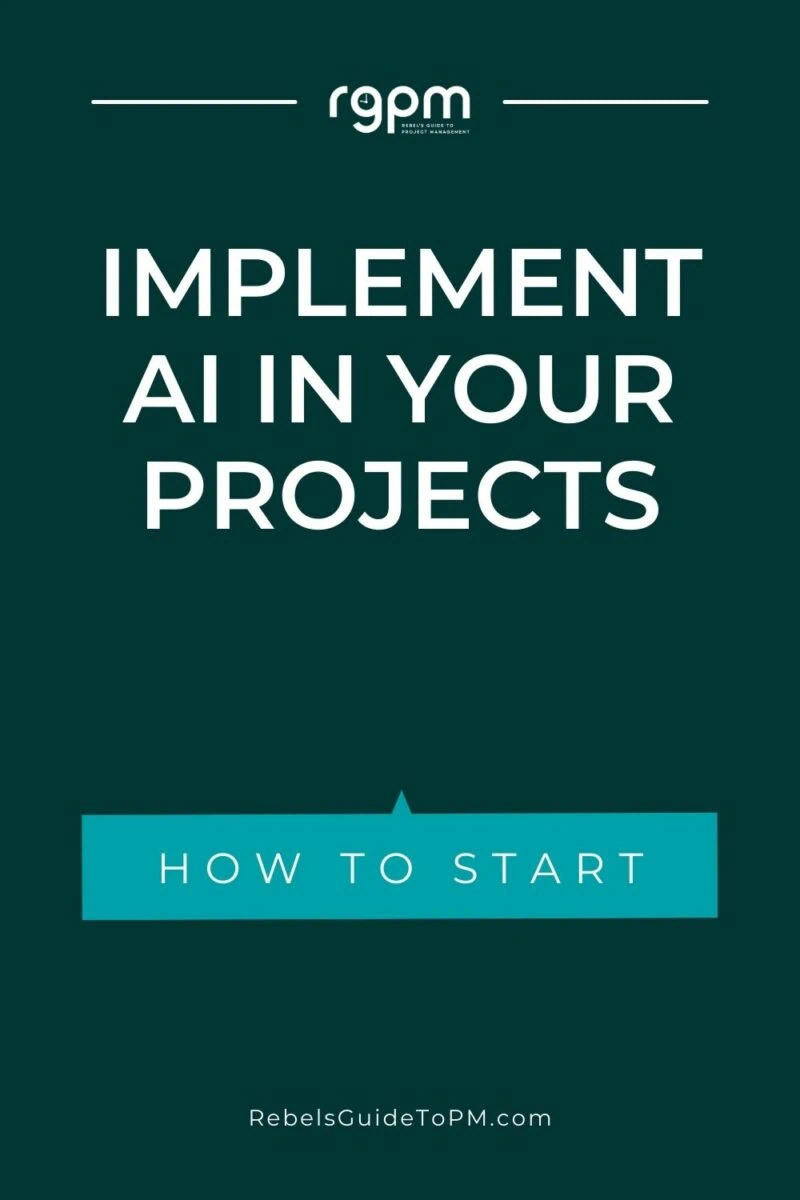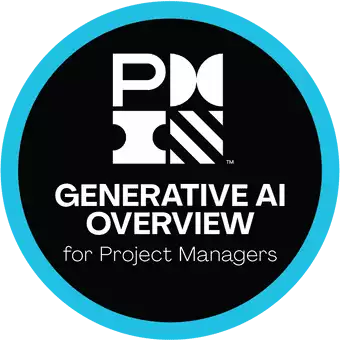Implementing AI in your projects: how to start and improve
This blog is reader-supported. When you purchase something through an affiliate link on this site, I may earn some coffee money. Thanks! Learn more.
If you are like many project professionals, you have likely worked with artificial intelligence (AI) in some capacity. In our annual global survey, one in five (21 percent) respondents say they are using AI always or often in project management, and there are plenty of other statistics about AI in project management that show the growing use.
Whether you’re already comfortable leveraging AI for projects, or you’re completely new to AI, one thing is certain: the rise of ChatGPT and other commercial generative AI has greatly accelerated AI’s workplace infiltration.
For project professionals, this means two things:
- AI is an extraordinary tool to automate administrative tasks to free up time for high-value activities, but it can even help enhance your interpersonal skills like collaboration and leadership – we call these “power skills.”
- Project professionals will likely be tasked with leading corporate digital transformation efforts to implement AI tools at scale.
The need is clear: project professionals must start (or continue) adopting AI tools – and GenAI tools in particular – into their daily work.
In this article, we will cover strategies to usher in this adoption and certain tasks that can be augmented with AI. Note that the platforms we recommend using include ChatGPT-4, Gemini, MS Copilot, and Smartsheet; however, there are many tools to choose from, each with specific benefits, drawbacks, and limitations.
How do I begin automating tasks?
For any professional looking to adopt AI, the logical first question is, “Where do I begin?” For project professionals, we recommend exploring AI tools by first understanding what project tasks and deliverables can be automated easily and without risk.
These tasks can be reviewed under two main dimensions: complexity and degree of human intervention required.
First look at the complexity of the task, including how many variables are involved, what data is involved, and if the task requires specific project management knowledge.
Second, consider the degree of human intervention needed to get the desired result of the task – that is, if you asked AI to do it for you, how much additional work would be needed to ensure the output is quality?
The more complex the task – and the more human intervention needed – the harder it is to automate, at least until you have a better understanding of the AI tools available.
A quick and easy course aimed at project managers. Specifically focused on generative AI applications in projects, mainly ChatGPT.
The AI spectrum for tools
Using these two dimensions as guidance, project professionals can decide how to use AI tools on a spectrum that ranges from automation to assistance and, finally, augmentation.
The first level on the spectrum – automation – is the recommended starting point. Project professionals can automate tasks that are low complexity and require little human intervention in their final output. Examples include:
- Generating reports
- Analyzing documents with multiple types of data
- Summarizing meeting notes
- Organizing information into company templates
- Performing calculations.
As project managers get more practice using AI tools for automation tasks, they can create standard prompts they can reuse across projects and even by other team members, since these tasks generally do not need highly experienced project professionals to assess and verify the results.
What if I am more experienced?
As you continue experimenting with AI, you will be able to leverage its benefits for more complex tasks that require more human intervention.
The second level on our spectrum is assistance, where project professionals can leverage GenAI to complement analyses, create AI-driven first drafts of certain deliverables, and iteratively build expected outputs for certain tasks.
Examples of tasks that can be enhanced using AI at this level include:
- Creating a first draft of a cost-benefit analysis
- Performing a data analysis to be used on a scope change recommendation
- Creating scheduling plans
- Performing a risk analysis.
The resulting outputs will likely require moderate intervention from yourself or another experienced project professional to ensure they are complete and accurate – at this stage, the output from AI tools cannot be considered complete without human refinement.
Finally, the last – and most advanced – level is “augmenting,” where project leaders can both enhance existing capabilities and develop new ones.
This approach helps you perform more complex, strategic tasks specific to the organization or project, such as creating outstanding business cases for projects and supporting complex decision-making with many interdependencies and variables.
Ultimately, humans will still guide and perform most of the work, but they can leverage GenAI to gain insights and perform specific tasks using multiple interactions with the tool.
At this level, it is likely that the individual’s depth of experience and knowledge about their organization, industry, and project management will influence the quality of the final outcomes.

Using AI beyond deliverables
Our Pulse of the Profession research identified four power skills essential to helping organizations transform: strategic thinking, problem-solving, collaborative leadership, and communication.
All of these are human traits that, to some degree, can be augmented by AI:
- Enhancing strategic thinking: GenAI is familiar with strategic models and constructs. Even for those who do not fully understand their organization’s strategy, GenAI can flesh out what strategies for organizations like yours may look like, allowing you to include connection points to your organization’s strategy in your planning and deliverables.
- Cultivating better collaboration: Before brainstorming, having GenAI produce results for brainstorm questions can allow you to bring initial thinking to your team, allowing you to skip the “lowest common denominator” brainstorming that can predominate initial meetings.
- Giving new perspectives on problems: Problem-solving in project management requires diverse perspectives, and GenAI can offer a new perspective that can solve parts of problems, perform background research, and suggest hypotheses.
- Improving communication: GenAI can be used to help streamline communication across different levels, including stakeholder communication management, and automate simpler communication processes. It can also evaluate content to help convey the right narrative and perspective in more sensitive and complex messages.
These use cases can be used by professionals at any level of understanding with AI. However, this “perspective” offered by GenAI platforms is exactly that, a perspective.
Keep in mind that a human will still need to gather all information to find the best solution to any problem, and a project professional must always provide the “human touch” to communication and strategic thinking.
How can I get started?
I recommend playing around with free AI-enabled tools to determine their use cases and benefits. You can also assess the projects you are working on to determine where you can begin implementing AI in risk-free ways.
For those looking to dive deeper into AI-enabled project management, PMI continues to help project professionals in their mastery of AI. PMI also has a free foundational AI course, complete with information on how to strengthen inputs for GenAI tools.
AI is poised to continue its meteoric rise, and project professionals who fully embrace AI will see career advancement opportunities. The time to get started is now – even if that means just experimenting.

